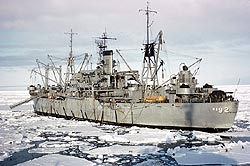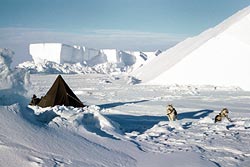Frazil Ice
In March, if there are clear skies and no wind with the sun low even at midday and dipping out of sight at midnight, the sea which is radiating off heat rapidly, drops to a temperature of 28.5 deg F. and begins to freeze. Small crystals of ice form and the water takes on a soupy appearance. These crystals are called “Frazil Ice”. We used to push through it rather slowly in a steel hulled landing craft called an “M Boat”, but it is not a good idea to stop as the frazil ice can become a thicker “Sludge Ice” and in a few hours, freeze solid, and there you are until next spring. Any moderately strong wind will however break it up, some years the sea may freeze many times and break up, often not until May or even June does it become solid enough to sledge on and then only in bays.
Pancake Ice
As the sea begins to freeze, unless it is VERY calm, it will form platelets growing to plates a foot or two across, with upturned edges where ripples splash and freeze. This is “pancake ice”.
New Ice
This is continuously solid and is only a few inches thick and looks green and translucent. One can sledge on it but it bends down a few inches under the weight of you and your sledge so you travel in a moving trough. Another sledge ahead or behind also forms a trough, so you advance on a moving wave. If one holds an ice chisel, which has a handle 6 ft long at knee height and drops it and it does not go through, it is safe. All the same, wear skiis and keep away from the heavy sled! Keep away from the ice edge, from polynya and places where water is showing. Drowning your dogs is a no no!
Pack Ice
 Supply ship in McMurdo Sound, Jan 1956 in fairly open pack ice, but unable to move because of ice against her propeller. We (in the icebreaker Edisto), washed it away. A nearby ship was nearly sunk, but survived with a 30ft gash in her hull. See the skuas after garbage. |
Eventually the whole of McMurdo Sound may freeze over into a single green sheet covered with a few inches of snow, but out beyond Beaufort Island, is the Ross Sea, the local home of storms. A gale and swell will soon break an ice sheet into separate blocks six, ten, twenty, an hundred feet across, perhaps six inches thick, perhaps a foot or two, but by the spring, perhaps five of six, even 10 feet thick.
They may pile up against each-other, or lie quite flat touching in places or separated by narrow leads of water. Heavy pack can be sledged over but your dogs must have long traces to be able to jump leads, (or even swim). If heavy pack is jammed quite tightly one can take tractors and loaded sledges across it, but the smaller floes may rock a bit and be sure that every open lead will have a killer whale or two sounding in it. If you are spotted they will follow on the off chance of a free meal. Sometimes half a dozen orcas will sound in a small triangular pool and this is where you can join the “Pat the Whale” club, by leaning out and slapping one on the ear. Do this from behind, not from the side with the teeth!
Do not try to sledge across pack in a strait subject to a strong tide flow for obvious reasons. I belong to the “Antarctic Swimming Club” myself, but the conditions of entry are not pleasant – it is like being smacked across the bare belly with the proverbial wet spade.
| |__| | Heavy pack |
| |__| | Open pack |
Pressure Ridges
A wind or tide will drift pack against a shore or against fast-ice, where it will pile up an a tangled line of blocks as much as fifty feet high. One may have to traverse to one side for miles to find a way through. Alternatively spend an hour or two chopping with an ice-axe. A massive pressure ridge of old pack ten feet thick will stop the biggest ice-breaker! One may be able to travel a mile on flat ice with hardly a crack, and then find a huge pressure ridge, or there may be several pressure ridges with only a hundred yards between them. On sea ice you never can tell. One could usually sledge from Scott Base over to Butter Point in two days, but if enough pressures ridges had formed it might take 3-4 days.
Bay Ice
In bays sea ice may not break up in the summer if it is sheltered from any swell and may remain for 2-3 years or more becoming a small ice shelf perhaps 10 – 20 feet thick. Good to unload cargo onto.
Rotten Ice
By early summer, the pack will be softening and becoming quite rotten losing all its strength. Rotten pack eight feet thick will not carry your weight, you sink through. Rotten ice is especially dangerous to take tractors on, keep your ice chisel handy. Hard ice 8in thick will take a heavy Weasel, rotten-ice ten feet thick will not. Several men have been drowned in McMurdo Sound when taking a vehicle or tractor onto rotten ice or ice that was too thin.
Ice Bergs
 A sheltered campsite on sea ice, about 15 miles south of Mawson Glacier. A flat-topped berg, a tilted berg (aground) and an eroded remnant bergy bit. It came with snow to hold the tent down, and fresh water available from the berg opposite. (sea-ice tends to be VERY salty.) Early November, 1957. |
Most of our ice bergs break off the edge of the Ross Ice shelf, but a few come from an ice-tongue, such as THE Ice Tongue, or the MacKay or Mawson where a glacier pushes out into the sea until a bit a few miles long breaks off. So there you are quietly sailing up McMurdo Sound and blocking the way is a piece of glacier 1000 ft thick and 3miles long in the way. The biggest berg I ever seen was a piece of the Ross Ice shelf round off Cape Crozier. We were steaming along in the old “Glacier” (now gone) in 1956 heading for Bay of Whales and there was a bergy bit, 400 miles long and 60 wide standing up 2-300ft out of the water (I kid you not!)
Took us a day and a half to get past the damn thing. We fired a few five inch shells at it, but they just bounced off in a spray of shattered chips – ice can take a lot of shock. A little bit only 60 miles long later broke off and drifted to Cape Bird and another bit only a few miles across moved round and blocked off most of McMurdo Sound. Watching it slowly coming closer was like being in a bottle and seeing a cork being pushed in. Four icebreakers the “Glacier”, the “Edisto”, the “Eastwind”, and the “Northwind” tried to push it away. They burned a lot of diesel oil, but I did not see the berg move much.
|__| A large flat-top berg blocking McMurdo Sound.
After a few days the current changed and it drifted off. Icebergs can be detected at night or in fog; hold your hand up and you can feel the cold; as though being radiated off, never mind what the smarties say, you can FEEL it.
